Fishing Report: 2021 Labor Day weekend

Redfish bite is red hot right now
Redfish action is hot lately with one of the best redfish bites this time of year we have seen in a very long while, says Captain Dylan Hubbard with Hubbard's Marina.
MADEIRA BEACH, Fla. - Every Friday morning, Captain Dylan Hubbard of Hubbard's Marina joins Good Day to fill viewers in on his fishing forecast as we head into the weekend.
Here is his fishing report for September 3, 2021.
Inshore
Red tide continues to improve around the area while remaining fairly high around John’s Pass, unfortunately. We still have tons of fish around. They are just more picky and less active.
However, the Tampa Bay area overall looks nearly clear while most of the low to background level readings are mostly along the coastline and intercostal waterways.
Keep an eye on the forecasts and reports via this link if you are interested.
Mackerel action is going well along the beaches, at the mouth of the bay, around local passes, and the bridges of Tampa Bay. Look for them earlier in the morning around these areas holding bait where water is deeper and good tidal flow is bringing a little cooler water. Most of the time, it’s easy to spot the mackerel action because there will be birds working the bait they have schooled up to the surface.
Use faster moving flashy lures with a quick retrieve, and only pausing occasionally to allow the lure to sink a bit. Keep it lower in the water. A trick to keep it from skipping the surface on a quicker retrieve is to let it sink down when it first lands and keep your rod tip as close to the surface of the water as you can or pointed straight down if fishing from a bridge or pier.

Fertilize your lawn without damaging the environment
This summer's massive red tide bloom has homeowners thinking about the size of their environmental footprint, especially when it comes to lawn fertilizers that feed algae blooms.
MORE: After red tide bloom, more homeowners considering 'green' fertilizers
Crevalle jack are really showing up in the area in more concentrated numbers which are often surprising when fishing the flats, mangroves, docks or around the bridges. If you’re looking for birds to find mackerel, sometimes it may be a big school of these jacks instead of mackerel which brings tons of fun too.
Jacks will hit just about anything you throw at them and when they are in a frenzy even a bare hook with some weight and a blade of grass with get you a fish! Plus, they fight, so well they really make an enjoyable time for any angler. I always keep a rod rigged and ready in my office this time of year if I see them start to roll through the pass. There’s nothing better than a nice jack hook up to get your blood pumping. Like mackerel, fast retrieve with a heavier flashy lure, spoon or gotcha plug is a great option for a fun to fight Jack crevalle.
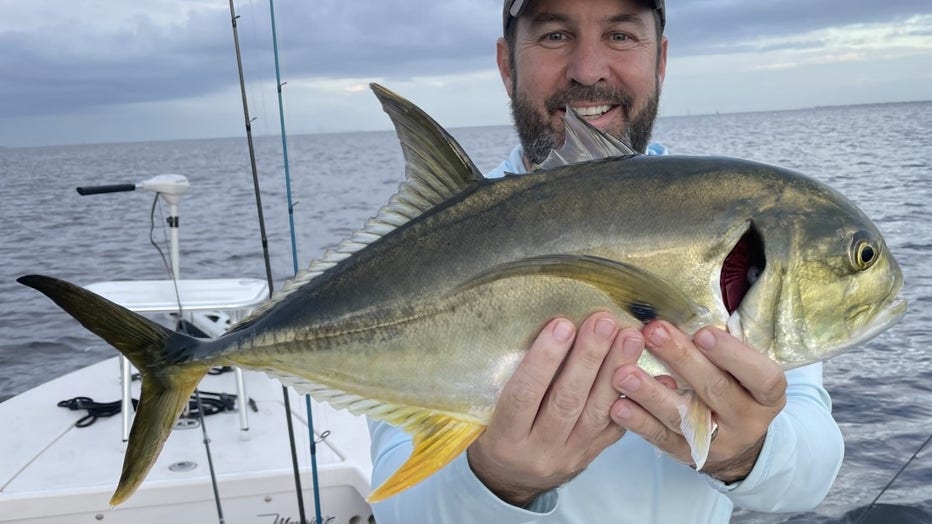
Jack crevalle (Credit: Hubbard's Marina)
Mangrove snapper are still thick around the area and local docks, piers, bridges, jetties and virtually any structures are producing good size and quality. Deeper water from 8 feet and beyond is where we are seeing the bigger mangroves but even against the seawall you will find these fish. Just the overall size gets larger the deeper you venture. Around the bridges, rock piles and shipping channel of Tampa Bay, we are seeing nearly offshore-class mangroves being caught occasionally. Use that lighter tackle and pieces of shrimp or cut greenbacks for bait.
Snook action is steady around the area. We are seeing a good number of fish still on the beaches and around the passes. However, the major concentration of snook seems to be moving back lately to the grass flats, mangroves, and canal points on the way from the passes to the back bay flats.

Snook (Credit: Hubbard's Marina)
Study the area and look for combinations of moving water, shade, wave or current action and cooler temperatures -- like the early morning or dusk or overnight -- for the best snook action. They are opportunistic feeders when the water is so warm, trying to expel as little energy as possible while hanging in an area with the most dissolved oxygen content like that shady area, moving water, or where waves or current is disturbing the surface enough to provide more oxygen entering the system.
Redfish action is red hot lately with one of the best redfish bites this time of year we have seen in a very long while. They are loving the crustaceans, like shrimp and crabs but will eat fine on the cut bait or soft plastic paddle tails. The incoming tide around the passes seems to be the best time to target them. Back in the bay, look for them around the shade of the mangroves, docks, or bridges or in the early morning around the flats, oyster bars, or dock lines.
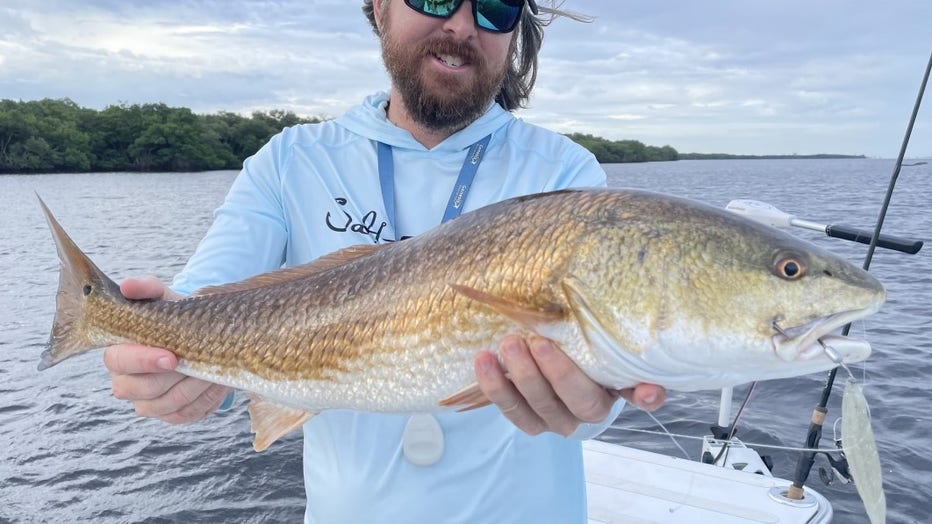
Redfish (Credit: Hubbard's Marina)
Trout action is going best around those deeper flats in the 5-8 feet range. Deeper water means they can tuck into cooler waters and more current can move through bringing again cooler waters with fresh oxygen rick water. The warmer waters hold less oxygen, so during the heat of the day, the trout will hang in holes, on the edges or at deeper flats to find that cooler more oxygen rich area.
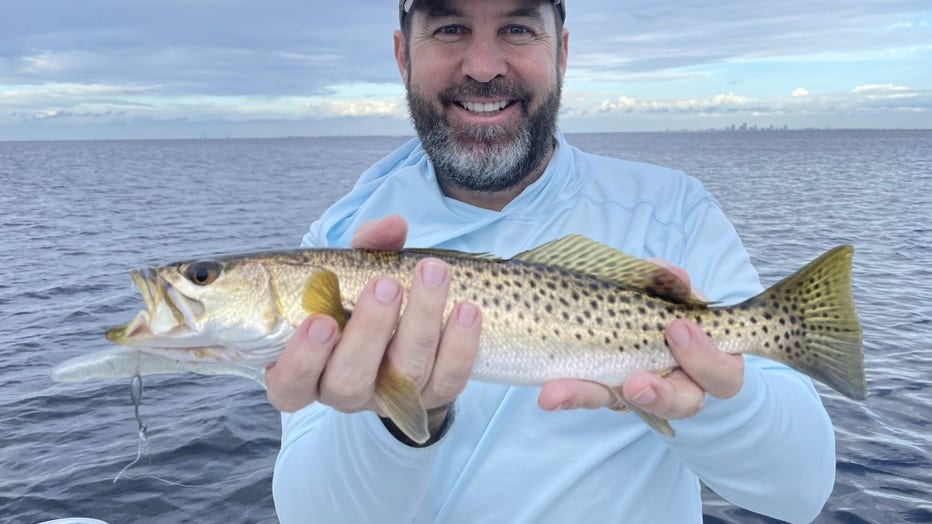
Trout (Credit: Hubbard's Marina)
Plus, like snook they are more opportunistic this time of year too. At night, the dock lights tend to fill up with hungry, more active trout especially this week on the new moon phase, the dock light fishing and bridge light shadow lines should be loaded down with trout on the surface, occasional snook and redfish towards the bottom.
Near shore
Red grouper continue to bite well in the deepest near shore waters. We are seeing the most fish beyond the near shore waters from the shallower to the deepest, and offshore waters beyond 100 feet. We’re still catching steady numbers of keeper-sized red grouper in the deepest near shore waters from around 80-100 feet of water.
You can find keeper red grouper as shallow as 40-50 feet, but the more common keeper-sized fish become more prevalent the deeper you get. Like many fish, they are in search of cooler, more active waters. Look for them in the potholes, cuts, hardbottom or small ledges type areas.
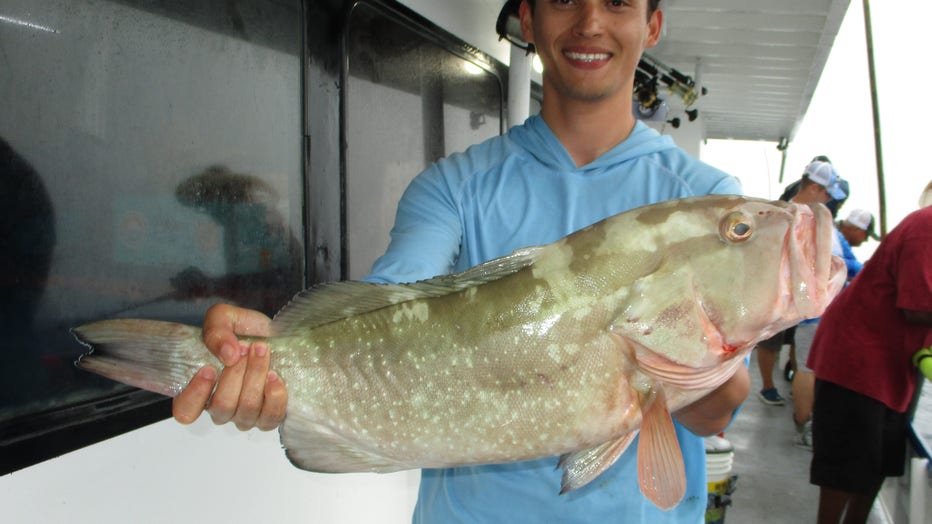
Red grouper (Credit: Hubbard's Marina)
Mangrove snapper are coming up in a steady clip near shore around 60-100 feet of water. We are seeing some steady action and some overall size that is impressive. However, like the red grouper, the bigger fish seem to be most common the deeper you go. Keep that lighter tackle double snell rig ready with 30-40lb test leader and 4-5ot hooks using cut thread fin.
You can also use around a 30lb leader and a single hook with live shrimp or a smaller chunk of threadfin or squid to target those near shore mangrove snapper. This way, they get more pressure and tend to be more leader shy in those shallower brighter near shore waters. With the new moon action this week, we should see more mangroves biting better during the daytime hours.
Lane snappers continue to bite well near shore from around 50-100 feet of water we are seeing steady lane snapper on a variety of baits. Shrimp, cut threadfin or even squid works to target the lane snapper. These guys will often be found around similar structures as the red grouper and are a great bycatch when targeting the mangrove snapper using that same set up rig wise recommended above.
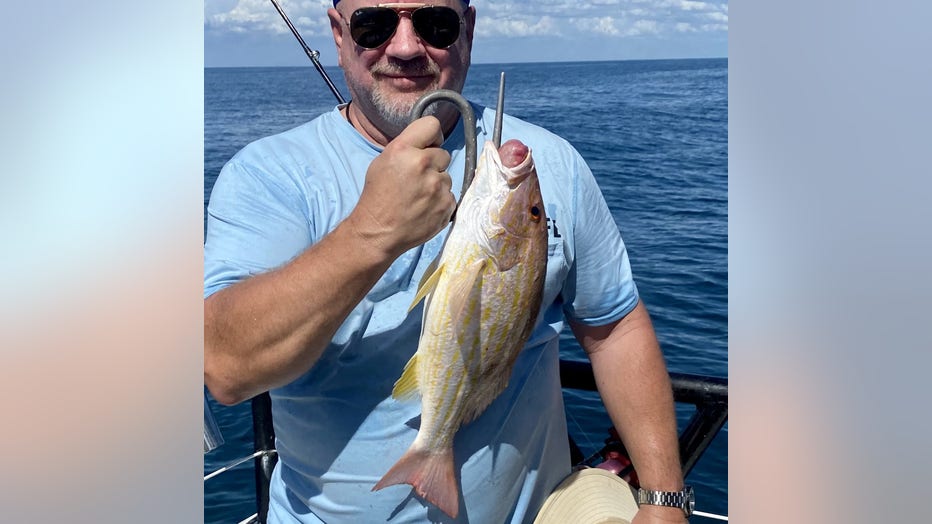
Lane snapper (Credit: Hubbard's Marina)
Gag grouper action is very tough near shore right now overall unless you’re up in the bay around the shipping channel or passing near shore waters to head out deeper. Lots of these guys get broken off near shore when targeting the snapper or hogfish using light tackle and often the spinning gear.
Remember, spinning reels have higher gear ratios and the higher the gear ratio like 5:1 or better, the more speed your line will retrieve with but the less torque or power. The lower the gear ratio, you may have more power and torque, but your speed greatly diminishes. If you have the budget, a two-speed convention solves this dilemma, or you could use a more medium gear ratio with a solid drag to get the job done until you can get that two-speed set up.
Mahi mahi are still the near shore pelagic action right now. We are seeing the occasional peanut or chicken dolphin show up alongside the boat while bottom fishing. You got to be ready with the pitch rod to cast out if you see them swim up or swim by.
Offshore
Amberjack season continues for another two months plus right now the triggerfish season is still open as well!
It’s a great time to head out deep for a chance at some amberjack and big triggerfish beyond around 140 feet of water or more. The deeper you go, the bigger the jacks and triggerfish will be. Plus, when fishing deeper, our chances for the gag grouper bite to pick up for us is more common.
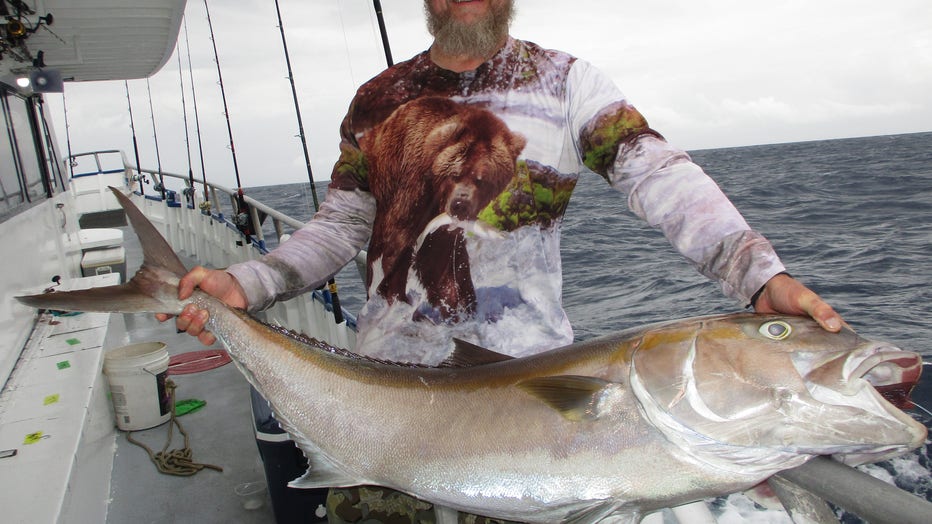
Amberjack (Credit: Hubbard's Marina)
Red grouper are really biting well right now, but you’re still wading through a lot of the undersized red grouper to get to the keeper fish. Make sure to get them up quick, get them dehooked using a nice dehooking tool and then vent or descend them quickly so they can live to fight another day and get big enough to keep.
This time of year, once around 80-90 feet of water, often even that shallow, you will have to vent your fish when the water and air are so hot.
The recent 39-hour mid-week trip crushed the plentiful yellowtail snapper, mangrove snapper, almaco jacks, vermillions, porgies and some red grouper to round out the reef fish with some big jacks mixed in as well.
The yellowtail are thick it seems right now, and Will McClure was fishing this trip for fun, messing up the yellowtail on a chick rig with around 4o/t hooks and a 30-40lb leader. The weather has made it tougher to get out there offshore lately but that seems to be improving over the week for the next week or so!
Mahi mahi, wahoo, and occasional kingfish are the most common offshore pelagics this time of year. Have those flat lines and pitch rods ready if you’re heading offshore this time of year.
DON’T BE A FOOL, bring a venting tool & Descending device
Keep in mind the importance of dead discards and discard mortality when engaged in near shore or offshore fishing. How many do you know right now that are all for catching and releasing snook, redfish, and trout but will be the first in line to kill a mangrove snapper, gag grouper, or red snapper? But the attitude completely changes when discussing these offshore species?
Plus, the same person inshore that will hold their breath and wet their hands before handling a breeder snook will go offshore and then cull through 20 red snapper before keeping their two red snapper they deem large enough to fill their two-fish bag limits. Meanwhile, the other 18 they released will often end up suffering fatal damage if not properly descended or vented?
Please help us to spread the word on the importance of descending or venting your released fish. Descending devices are most easy to use and quick to pick up on their use. They are most effective for most anglers.
However, an expert and precise angler with proper training and tons of experience can use a venting tool properly with similar outcomes. A venting tool requires you to pierce the fish while most descending devices are much less invasive. While using a venting tool, it is imperative you pierce them in the exact right spot, and you do not go but a quarter-inch or less in the fish. Most venting tools require you to ‘choke up’ on the tool to prevent over-penetration into major organs.
When fishing deep water, especially in the hot summer months, please make sure to treat all fish intended to be released like that breeder snook inshore and minimize the time it takes you to get him from the bottom to the boat using heavier proper tackle, not an ultra-light spinning reel.
Then once onboard, minimize the time out of the water. Then use a proper de-hooking tool and then, for the love of God, use a descending device or venting tool PROPERLY to ensure that fish has a chance to live another day.
Three things will help ensure the survivability of those fish released offshore:
- Making sure they are brought up quickly and do not expend all their energy in the fight.
- Make sure they are unhooked smoothly, easily, and as quickly as possible.
- Finally, make sure they spend the least amount of time at the surface at negative pressures where barotrauma exponentially increases its effect with each passing second.
Also, keep in mind when the water is warm, there is less dissolved oxygen content and the chances of barotrauma increase even more while its effects can be even more deadly.
LINK: Here’s all the information and more on barotrauma and how to mitigate that fatal damage to your future offshore catch
**Note: I recommend the Salt Strong articles at the bottom of the page under ‘webpages.’ I helped them develop those personally.
STATE SURVEY to improve recreational data and access
It is imperative that you have your Gulf Reef Fish survey endorsement on your fishing license.
You should get one if you are a private recreational angler or diver fishing from a private boat anywhere in Florida who intends to harvest, attempt to harvest or possess one or more of the following reef fish species: mutton snapper, yellowtail snapper, hogfish, red snapper, vermilion snapper, gag grouper, red grouper, black grouper, greater amberjack, lesser amberjack, banded rudderfish, almaco jack, gray triggerfish, Gag grouper, Red grouper, Scamp grouper, Mangrove snapper, Lane snapper, Kingfish, Tuna, or Mahi mahi.
Here is all the information and more on that program and how you can sign up.
TERMS OF REFERENCE:
INSHORE – from the back bays out to the bridges and including right on the beaches
NEAR SHORE – From the beaches out to 20 miles, or up to 100ft of water
OFFSHORE – from 20 miles or 100ft and beyond
For more fishing reports, photos, videos and more check out Hubbard’s Marina on Facebook, Instagram, YouTube, or Snapchat. Just simply search "HubbardsMarina" and do not forget our family motto, "If you’re too busy to go fishing, you’re just too busy!

